UNCC300 Assessment: Ageism in Health Care - Analysis and Impact
VerifiedAdded on 2022/11/24
|5
|1139
|195
Essay
AI Summary
This essay examines the pervasive issue of ageism within the healthcare system, focusing on its detrimental effects on the elderly and the overall quality of care. The essay begins by defining ageism and its prevalence, highlighting the demographic shifts contributing to the problem. It then delves into the core arguments, including how ageism leads to inequality and discrimination in healthcare, with examples of over-treatment and unfair resource allocation. The essay references studies that demonstrate how ageist attitudes among healthcare professionals contribute to poor patient outcomes and substandard care, including workforce shortages. The essay concludes by emphasizing the need for collective efforts to bridge the skills gap between experienced and inexperienced staff, ensuring a smooth transition and maintaining high-quality services for all patients. References are provided.
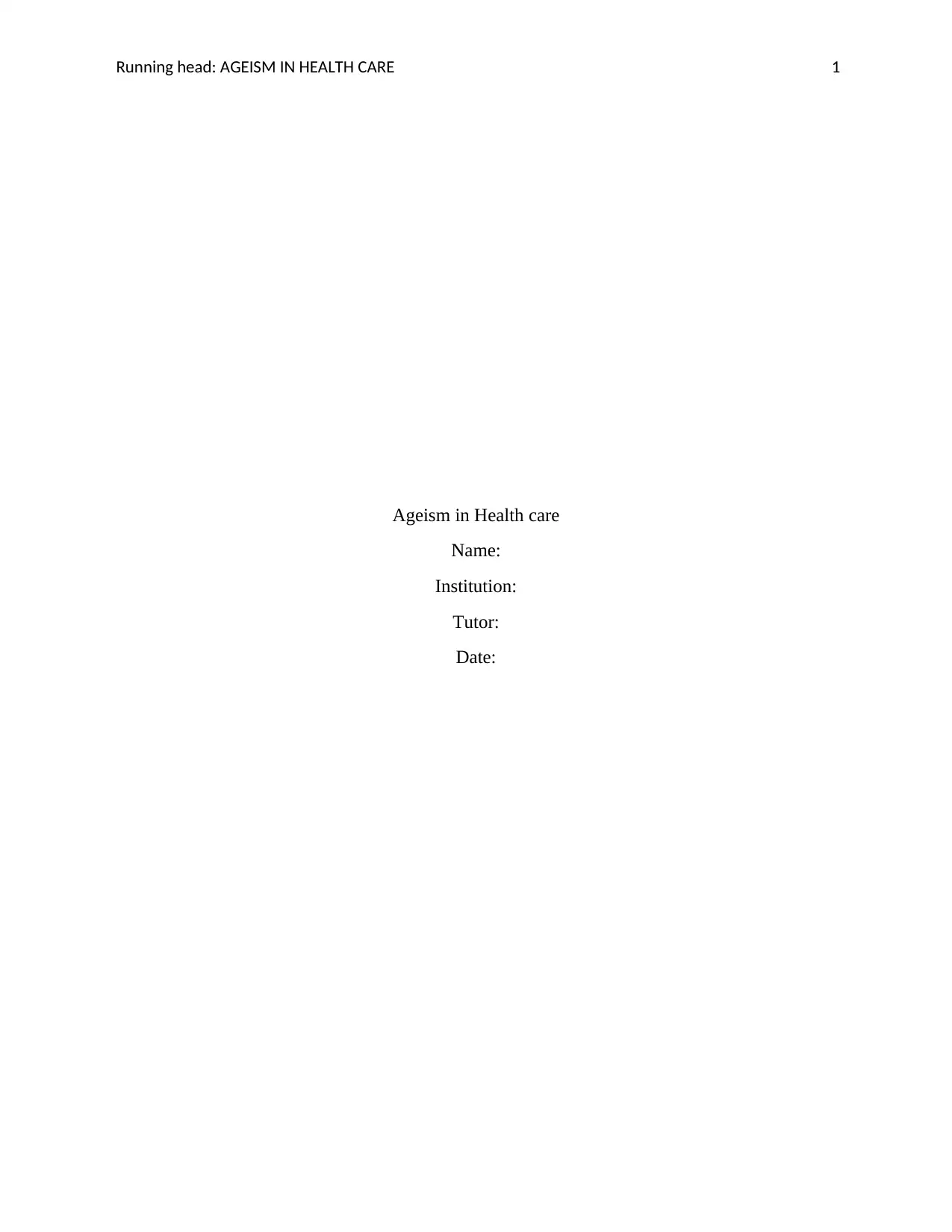
Running head: AGEISM IN HEALTH CARE 1
Ageism in Health care
Name:
Institution:
Tutor:
Date:
Ageism in Health care
Name:
Institution:
Tutor:
Date:
Paraphrase This Document
Need a fresh take? Get an instant paraphrase of this document with our AI Paraphraser
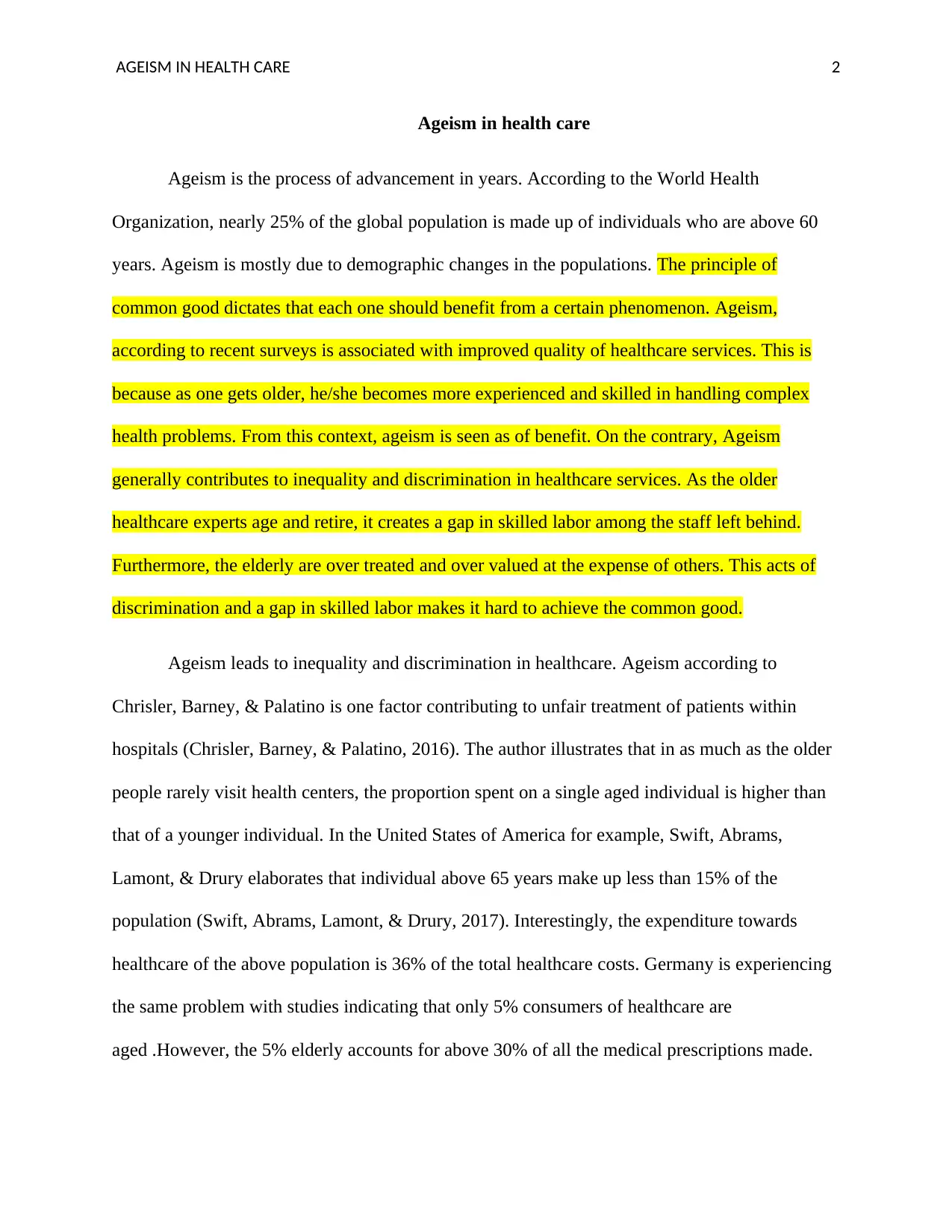
AGEISM IN HEALTH CARE 2
Ageism in health care
Ageism is the process of advancement in years. According to the World Health
Organization, nearly 25% of the global population is made up of individuals who are above 60
years. Ageism is mostly due to demographic changes in the populations. The principle of
common good dictates that each one should benefit from a certain phenomenon. Ageism,
according to recent surveys is associated with improved quality of healthcare services. This is
because as one gets older, he/she becomes more experienced and skilled in handling complex
health problems. From this context, ageism is seen as of benefit. On the contrary, Ageism
generally contributes to inequality and discrimination in healthcare services. As the older
healthcare experts age and retire, it creates a gap in skilled labor among the staff left behind.
Furthermore, the elderly are over treated and over valued at the expense of others. This acts of
discrimination and a gap in skilled labor makes it hard to achieve the common good.
Ageism leads to inequality and discrimination in healthcare. Ageism according to
Chrisler, Barney, & Palatino is one factor contributing to unfair treatment of patients within
hospitals (Chrisler, Barney, & Palatino, 2016). The author illustrates that in as much as the older
people rarely visit health centers, the proportion spent on a single aged individual is higher than
that of a younger individual. In the United States of America for example, Swift, Abrams,
Lamont, & Drury elaborates that individual above 65 years make up less than 15% of the
population (Swift, Abrams, Lamont, & Drury, 2017). Interestingly, the expenditure towards
healthcare of the above population is 36% of the total healthcare costs. Germany is experiencing
the same problem with studies indicating that only 5% consumers of healthcare are
aged .However, the 5% elderly accounts for above 30% of all the medical prescriptions made.
Ageism in health care
Ageism is the process of advancement in years. According to the World Health
Organization, nearly 25% of the global population is made up of individuals who are above 60
years. Ageism is mostly due to demographic changes in the populations. The principle of
common good dictates that each one should benefit from a certain phenomenon. Ageism,
according to recent surveys is associated with improved quality of healthcare services. This is
because as one gets older, he/she becomes more experienced and skilled in handling complex
health problems. From this context, ageism is seen as of benefit. On the contrary, Ageism
generally contributes to inequality and discrimination in healthcare services. As the older
healthcare experts age and retire, it creates a gap in skilled labor among the staff left behind.
Furthermore, the elderly are over treated and over valued at the expense of others. This acts of
discrimination and a gap in skilled labor makes it hard to achieve the common good.
Ageism leads to inequality and discrimination in healthcare. Ageism according to
Chrisler, Barney, & Palatino is one factor contributing to unfair treatment of patients within
hospitals (Chrisler, Barney, & Palatino, 2016). The author illustrates that in as much as the older
people rarely visit health centers, the proportion spent on a single aged individual is higher than
that of a younger individual. In the United States of America for example, Swift, Abrams,
Lamont, & Drury elaborates that individual above 65 years make up less than 15% of the
population (Swift, Abrams, Lamont, & Drury, 2017). Interestingly, the expenditure towards
healthcare of the above population is 36% of the total healthcare costs. Germany is experiencing
the same problem with studies indicating that only 5% consumers of healthcare are
aged .However, the 5% elderly accounts for above 30% of all the medical prescriptions made.
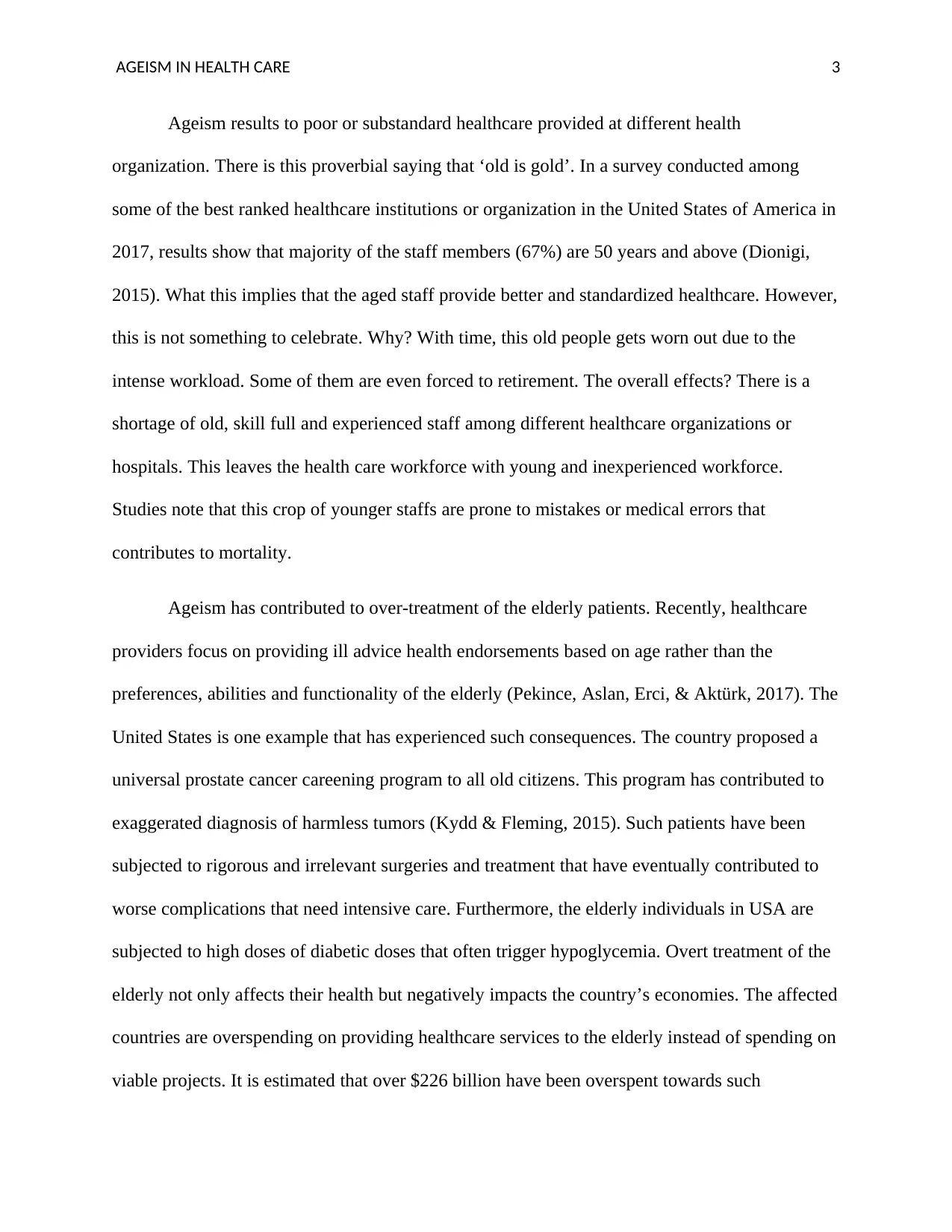
AGEISM IN HEALTH CARE 3
Ageism results to poor or substandard healthcare provided at different health
organization. There is this proverbial saying that ‘old is gold’. In a survey conducted among
some of the best ranked healthcare institutions or organization in the United States of America in
2017, results show that majority of the staff members (67%) are 50 years and above (Dionigi,
2015). What this implies that the aged staff provide better and standardized healthcare. However,
this is not something to celebrate. Why? With time, this old people gets worn out due to the
intense workload. Some of them are even forced to retirement. The overall effects? There is a
shortage of old, skill full and experienced staff among different healthcare organizations or
hospitals. This leaves the health care workforce with young and inexperienced workforce.
Studies note that this crop of younger staffs are prone to mistakes or medical errors that
contributes to mortality.
Ageism has contributed to over-treatment of the elderly patients. Recently, healthcare
providers focus on providing ill advice health endorsements based on age rather than the
preferences, abilities and functionality of the elderly (Pekince, Aslan, Erci, & Aktürk, 2017). The
United States is one example that has experienced such consequences. The country proposed a
universal prostate cancer careening program to all old citizens. This program has contributed to
exaggerated diagnosis of harmless tumors (Kydd & Fleming, 2015). Such patients have been
subjected to rigorous and irrelevant surgeries and treatment that have eventually contributed to
worse complications that need intensive care. Furthermore, the elderly individuals in USA are
subjected to high doses of diabetic doses that often trigger hypoglycemia. Overt treatment of the
elderly not only affects their health but negatively impacts the country’s economies. The affected
countries are overspending on providing healthcare services to the elderly instead of spending on
viable projects. It is estimated that over $226 billion have been overspent towards such
Ageism results to poor or substandard healthcare provided at different health
organization. There is this proverbial saying that ‘old is gold’. In a survey conducted among
some of the best ranked healthcare institutions or organization in the United States of America in
2017, results show that majority of the staff members (67%) are 50 years and above (Dionigi,
2015). What this implies that the aged staff provide better and standardized healthcare. However,
this is not something to celebrate. Why? With time, this old people gets worn out due to the
intense workload. Some of them are even forced to retirement. The overall effects? There is a
shortage of old, skill full and experienced staff among different healthcare organizations or
hospitals. This leaves the health care workforce with young and inexperienced workforce.
Studies note that this crop of younger staffs are prone to mistakes or medical errors that
contributes to mortality.
Ageism has contributed to over-treatment of the elderly patients. Recently, healthcare
providers focus on providing ill advice health endorsements based on age rather than the
preferences, abilities and functionality of the elderly (Pekince, Aslan, Erci, & Aktürk, 2017). The
United States is one example that has experienced such consequences. The country proposed a
universal prostate cancer careening program to all old citizens. This program has contributed to
exaggerated diagnosis of harmless tumors (Kydd & Fleming, 2015). Such patients have been
subjected to rigorous and irrelevant surgeries and treatment that have eventually contributed to
worse complications that need intensive care. Furthermore, the elderly individuals in USA are
subjected to high doses of diabetic doses that often trigger hypoglycemia. Overt treatment of the
elderly not only affects their health but negatively impacts the country’s economies. The affected
countries are overspending on providing healthcare services to the elderly instead of spending on
viable projects. It is estimated that over $226 billion have been overspent towards such
⊘ This is a preview!⊘
Do you want full access?
Subscribe today to unlock all pages.

Trusted by 1+ million students worldwide
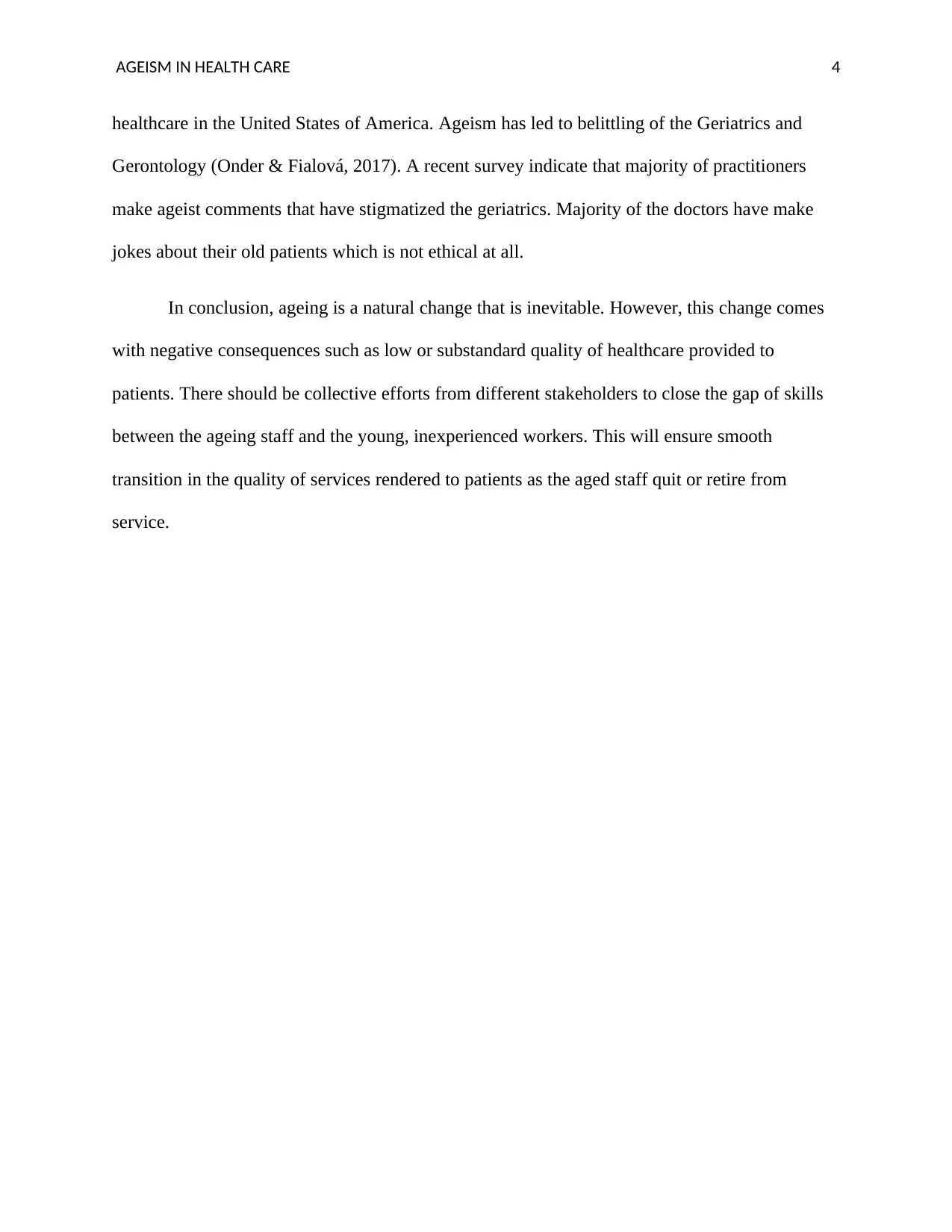
AGEISM IN HEALTH CARE 4
healthcare in the United States of America. Ageism has led to belittling of the Geriatrics and
Gerontology (Onder & Fialová, 2017). A recent survey indicate that majority of practitioners
make ageist comments that have stigmatized the geriatrics. Majority of the doctors have make
jokes about their old patients which is not ethical at all.
In conclusion, ageing is a natural change that is inevitable. However, this change comes
with negative consequences such as low or substandard quality of healthcare provided to
patients. There should be collective efforts from different stakeholders to close the gap of skills
between the ageing staff and the young, inexperienced workers. This will ensure smooth
transition in the quality of services rendered to patients as the aged staff quit or retire from
service.
healthcare in the United States of America. Ageism has led to belittling of the Geriatrics and
Gerontology (Onder & Fialová, 2017). A recent survey indicate that majority of practitioners
make ageist comments that have stigmatized the geriatrics. Majority of the doctors have make
jokes about their old patients which is not ethical at all.
In conclusion, ageing is a natural change that is inevitable. However, this change comes
with negative consequences such as low or substandard quality of healthcare provided to
patients. There should be collective efforts from different stakeholders to close the gap of skills
between the ageing staff and the young, inexperienced workers. This will ensure smooth
transition in the quality of services rendered to patients as the aged staff quit or retire from
service.
Paraphrase This Document
Need a fresh take? Get an instant paraphrase of this document with our AI Paraphraser
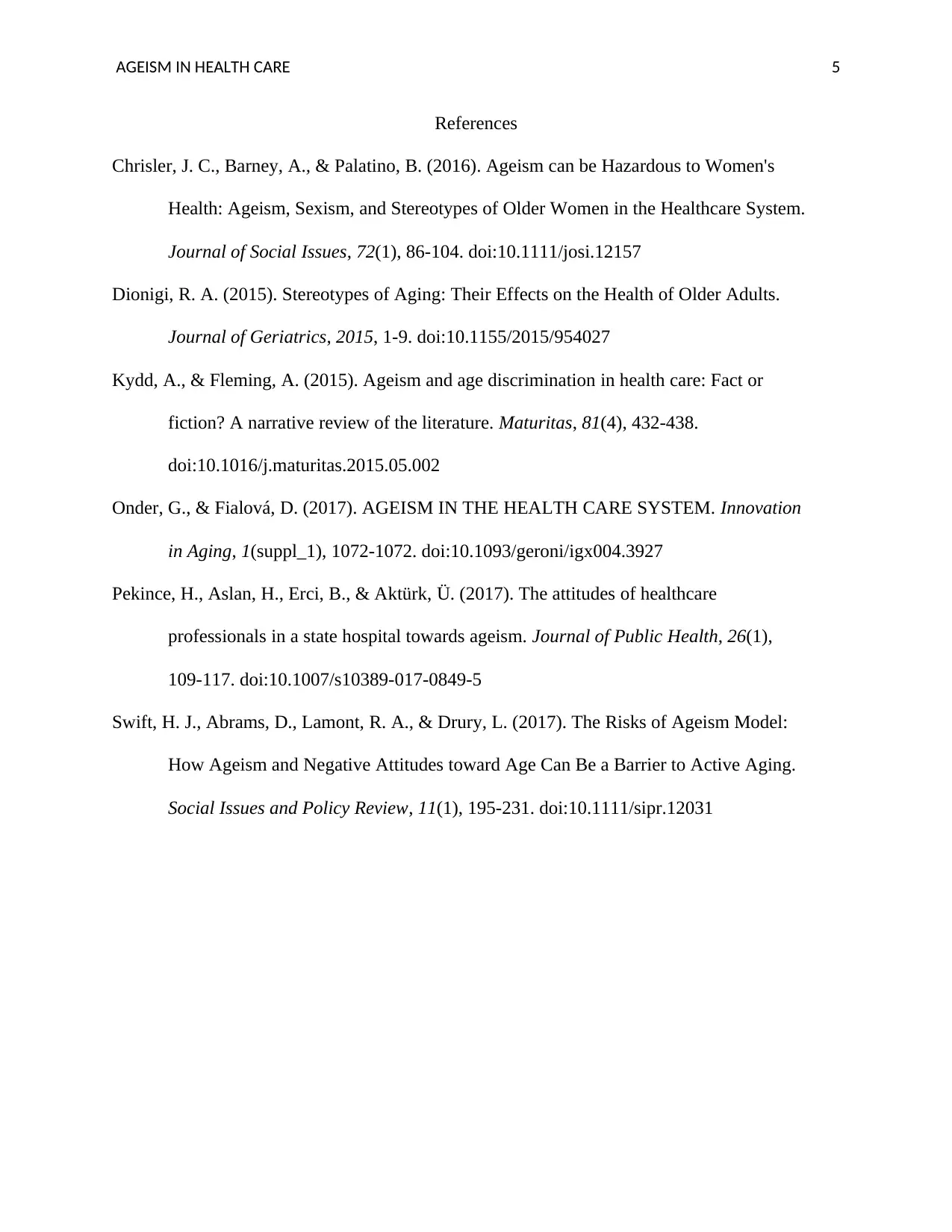
AGEISM IN HEALTH CARE 5
References
Chrisler, J. C., Barney, A., & Palatino, B. (2016). Ageism can be Hazardous to Women's
Health: Ageism, Sexism, and Stereotypes of Older Women in the Healthcare System.
Journal of Social Issues, 72(1), 86-104. doi:10.1111/josi.12157
Dionigi, R. A. (2015). Stereotypes of Aging: Their Effects on the Health of Older Adults.
Journal of Geriatrics, 2015, 1-9. doi:10.1155/2015/954027
Kydd, A., & Fleming, A. (2015). Ageism and age discrimination in health care: Fact or
fiction? A narrative review of the literature. Maturitas, 81(4), 432-438.
doi:10.1016/j.maturitas.2015.05.002
Onder, G., & Fialová, D. (2017). AGEISM IN THE HEALTH CARE SYSTEM. Innovation
in Aging, 1(suppl_1), 1072-1072. doi:10.1093/geroni/igx004.3927
Pekince, H., Aslan, H., Erci, B., & Aktürk, Ü. (2017). The attitudes of healthcare
professionals in a state hospital towards ageism. Journal of Public Health, 26(1),
109-117. doi:10.1007/s10389-017-0849-5
Swift, H. J., Abrams, D., Lamont, R. A., & Drury, L. (2017). The Risks of Ageism Model:
How Ageism and Negative Attitudes toward Age Can Be a Barrier to Active Aging.
Social Issues and Policy Review, 11(1), 195-231. doi:10.1111/sipr.12031
References
Chrisler, J. C., Barney, A., & Palatino, B. (2016). Ageism can be Hazardous to Women's
Health: Ageism, Sexism, and Stereotypes of Older Women in the Healthcare System.
Journal of Social Issues, 72(1), 86-104. doi:10.1111/josi.12157
Dionigi, R. A. (2015). Stereotypes of Aging: Their Effects on the Health of Older Adults.
Journal of Geriatrics, 2015, 1-9. doi:10.1155/2015/954027
Kydd, A., & Fleming, A. (2015). Ageism and age discrimination in health care: Fact or
fiction? A narrative review of the literature. Maturitas, 81(4), 432-438.
doi:10.1016/j.maturitas.2015.05.002
Onder, G., & Fialová, D. (2017). AGEISM IN THE HEALTH CARE SYSTEM. Innovation
in Aging, 1(suppl_1), 1072-1072. doi:10.1093/geroni/igx004.3927
Pekince, H., Aslan, H., Erci, B., & Aktürk, Ü. (2017). The attitudes of healthcare
professionals in a state hospital towards ageism. Journal of Public Health, 26(1),
109-117. doi:10.1007/s10389-017-0849-5
Swift, H. J., Abrams, D., Lamont, R. A., & Drury, L. (2017). The Risks of Ageism Model:
How Ageism and Negative Attitudes toward Age Can Be a Barrier to Active Aging.
Social Issues and Policy Review, 11(1), 195-231. doi:10.1111/sipr.12031
1 out of 5
Related Documents
Your All-in-One AI-Powered Toolkit for Academic Success.
+13062052269
info@desklib.com
Available 24*7 on WhatsApp / Email
![[object Object]](/_next/static/media/star-bottom.7253800d.svg)
Unlock your academic potential
Copyright © 2020–2025 A2Z Services. All Rights Reserved. Developed and managed by ZUCOL.





